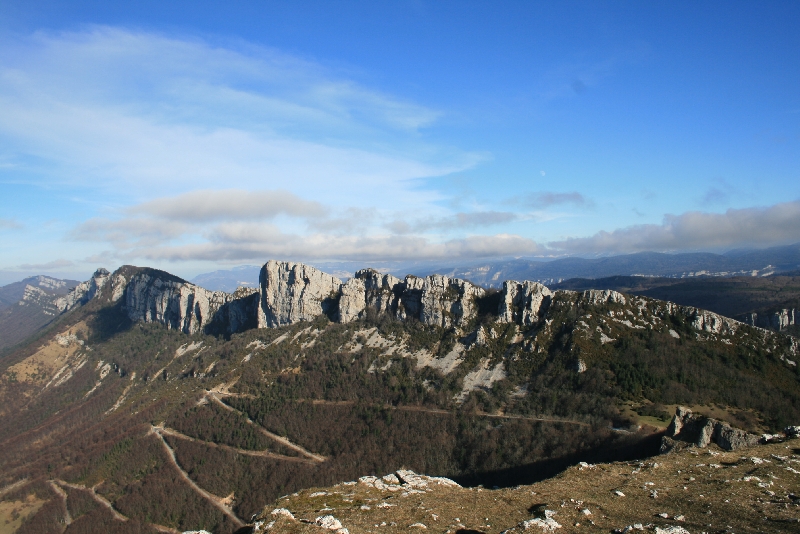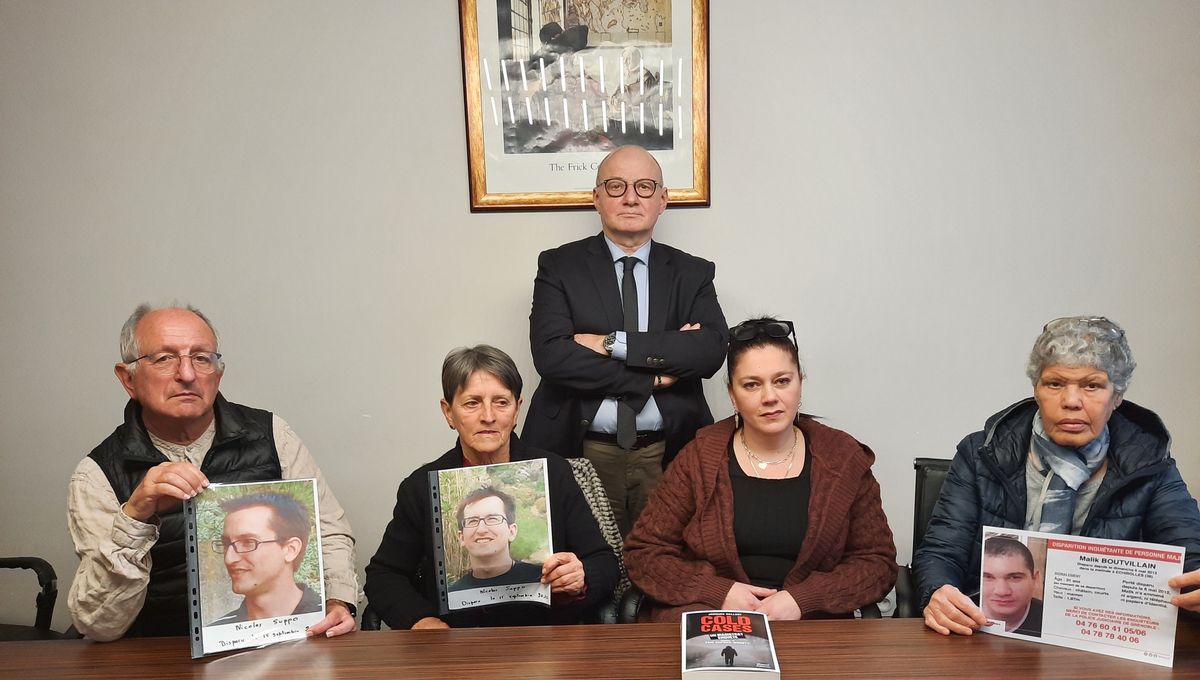https://www.ouest-france.fr/societe...de-tamie-c177b06a-6c9b-11ed-a961-e46de8a30dc6
STORY.
"I immediately sensed death": the shadow of Lelandais on the missing of the fort of Tamié
Jean-Christophe Morin disappeared in September 2011, during an evening of electronic music at the Fort de Tamié, high in the mountains of Savoie. A year later, almost to the day, during another edition of the event, Ahmed Hamadou vanished in the same forest. For more than a decade, the two families have been fighting to find out the truth. The file has finally arrived at the "cold cases" unit in Nanterre.
"Up there. That is what Farida Hamadou and Adeline Morin call the corner of the mountain where their brothers disappeared. Jean-Christophe Morin has not been heard from since he went to an electronic music party organised in the fort of Tamié, situated at an altitude of 992 m, on a promontory of forest overlooking Albertville (Savoie).
The following year, Ahmed Hamadou disappeared under similar circumstances. The press called them "the missing men of Fort Tamié". The arrest of Nordahl Lelandais for crimes committed in the region in 2017, then the discovery of a skull below the fort in 2020, have dusted off these two cases that seemed forgotten by the judicial institution. A few weeks ago, these disappearances were entrusted to a new investigating judge of the "cold cases" unit created at the Nanterre court (Hauts-de-Seine).
On Saturday 10 September 2011, Jean-Christophe and his friends decided to go to an electro party organised in the fort of Tamié. Part of the group leaves by car, Jean-Christophe and his friend Quentin, who do not have a car, join them by hitchhiking.
In the crowd, the two men lose sight of each other. A witness comes across Jean-Christophe, who seems panicked at the entrance to the fort. He tries to hold him back, but the young man struggles. He told him that someone was "after him", ran off in front of him and disappeared into the forest.
On Monday 12 September, Quentin found Jean-Christophe's truck empty. He went to the police station to report his disappearance. The following weekend, a childhood friend of the young man, Amandine, called Adeline to tell her that her brother had not been heard from. The sister went to the gendarmerie in Sallanches, then to the one in Albertville, closer to the fort. The gendarmes tell her that the first searches have taken place, but they cannot find any trace of Jean-Christophe.
In October, her family decides to organise a search around the fort and launches an appeal to the press. The Albertville gendarmerie tried to dissuade Adeline, without success. Gendarmes finally took part in the search, to help frame the process, in a sector made up of woods and cliffs. "What drives you crazy up there is that it's only forest", the sister of Jean-Christophe explains. "And then a man who runs, with adrenalin, he can go a long way. It's like looking for a needle in a haystack."
A final search took place at the end of October, with a helicopter from the high mountain police force (PGHM) and the help of dogs specialised in searching for bodies.
Only the young man's backpack was found, a few dozen metres opposite the entrance to the fort.
A simple procedure was put in place for "investigation in the interest of the families." Adeline then created a Facebook group dedicated to the disappearance of her brother, to try to obtain information and to spread the search notice. Christmas came and the young man gave no sign of life to his family.
A year passed and nothing had happened. On 8 September 2012, "Elementz III", a new edition of the electro event was organised. "We said to ourselves that we would go up there and look for people who had been at the party the previous year," Adeline Morin tells. During these electronic music events, people come back year after year, the public gathers from all over France and Europe. And what if a witness to Jean-Christophe's disappearance was present that evening and gave them new information? The family set up a stand near the entrance, distributed flyers and T-shirts bearing the image of the young man. The relatives did not get any new information that evening. But unknowingly, they witnessed a scene that would haunt them for a long time. "During the evening, we heard an altercation in front of the entrance.
In the fort's car park, two men were swerving in their cars. Security spotted them. As they arrived at the festival entrance, one of them got into an argument with the security guards, who refused to let them through. These are the voices heard by the family and friends of Jean-Christophe Morin.
The second man, who remains silent, is called Ahmed Hamdou. After the quarrel, he slips away. This is the last time he will be seen.
Our meeting with
Farida Hamadou almost never took place. The fault of a change of line and a capricious telephone. She finally receives us on a Tuesday evening in November 2022 in her cosy flat in the north-west of Chambéry, in Savoie. As the television runs without sound, she begins: "
I am Ahmed Hamadou's sister."
There were eleven siblings. Seven brothers, four sisters. "Now there are only seven of us. Ahmed is a year older than me." He would be 55 today. Until his death in 2012, he and Farida were close and saw each other regularly. "He lived eight hundred metres from here", in this neighbourhood of high buildings.
Among the siblings, he was the "joker", "a trickster", a "Robin Hood". He kept "bad company," his sister regrets, "He was not cautious."
On 8 September, he went out with Yan, an acquaintance he had met a few days earlier through his friend Julien. The two men scoured the bars of Albertville. They decide to go to the Fort de Tamié, where the electronic party is taking place, where Jean-Christophe disappeared one year earlier. But they never enter the fort, turned away by the security.
In mid-September, Farida has dinner at a friend's house, who tells her that the door to her brother's flat has been ajar for a few days. When she went there, the flat was empty. "I called the hospitals and the police to find out if anything had happened to him. No one saw Ahmed. "I immediately felt that something serious had happened. I immediately sensed death."
Farida Hamadou and Adeline Morin of course reported the disappearance of their brothers, but this had no real consequences. Because the two men are of age. "We were told: he has the right to disappear, he is an adult", laments Farida Hamadou. Preliminary investigations were opened under pressure from the families, according to their lawyer, Didier Seban. A notice of discontinuation for unsuccessful search was issued on 11 July 2014 in the case of Jean-Christophe Morin's disappearance, in June 2015 for that of Ahmed Hamadou.
The families were not informed.
"Even today, the families find themselves alone when faced with these disappearances. They will create a Facebook account with search notices and go to the courts. Unless it's the disappearance of a minor child, most of the time there is no investigation, there is no search," says Seban.
The context of the disappearance, an electronic festival, leads both women to believe that the investigators were less involved than in other situations. "I think they must have thought: 'They're all drug addicts, they're all a bit nuts'", Farida Hamadou assumes. "When we told the police that we were convinced that there was something going on, that it wasn't just a simple disappearance, they didn't want to know. It was a double shock," she continues. "They are "party people". Nobody cares", Adeline Morin agrees.
Some tell Farida and Adeline: "Forget it, he's made a new life for himself. Others say that their brother died of cold, at the foot of a tree. B
ut these two disappearances, from one year to the next, cannot be the result of coincidence for the families. "I can't accept this second disappearance," says Adeline Morin. "If there hadn't been this second 'disappearance', I would have said to myself: 'My brother fell into a crevasse'.
Nothing, or almost nothing, happens until the autumn of 2017. The broadcasters then began to focus on the murder of Maëlys, 7 years old, abducted and killed during a wedding in Pont-de-Beauvoisin, in Isère. Nordahl Lelandais, the number one suspect, was indicted on 30 November. A few weeks later, France learned that the girl was probably not his only victim. The former dog handler is under investigation for the murder of Corporal Arthur Noyer, who disappeared after a nightclub party in Chambéry in April 2017 and whose bones were found on a hiking trail in Montmélian, about 20 kilometres from the city.
Is Lelandais a serial killer? The press quickly made the rounds of unsolved cases in the region. The phones of the two women began to ring. Some journalists, who could not reach Farida Hamadou, rang her doorbell unexpectedly. Cameras came from Marseille and Paris. France 3 then wrote that "more or less close links exist" between the cases.
I
n January 2018, the national gendarmerie created the Ariane cell, based in Pontoise (Val-d'Oise), to investigate if Nordahl Lelandais could have been involved in other murders or disappearances. Of the 900 files studied, forty are identified for re-examination. Le Parisien claims that the case of the missing Tamié is one of them. "Apparently, the investigators were able to eliminate certain files because Nordahl Lelandais was not in these regions at that time. But tell me he wasn't there in 2011! Tell me he was somewhere else, in another department, in another country! I'm just waiting for this to be over and done," Adeline despairs. Since then, the Ariane cell has been dissolved, without the Hamadou and Morin families having any news.
Adeline and Farida finally met in 2017, on the set of the television programme Envoyé Spécial. They joined their grief. "We fell into each other's arms," says Jean-Christophe Morin's sister. "This is what has made us strong since. It is because we are together that we manage to make things happen.
In the first weeks of 2018, a journalist advised the two women to approach Maître Corinne Herrmann, associated with Didier Seban. The two lawyers are specialists in "cold cases", unsolved crimes, files that often gather dust in the offices of investigating judges.
The two families filed a complaint against X in March 2018 for "kidnapping and sequestration" before the Albertville court. No one had advised them to do so before.
In December 2018 and January 2019, Yan and Julien, who had made him meet Ahmed, were questioned again by the gendarmerie.
Months pass. Hunters find a skull in the rocky ridges below the fort of Tamié, in October 2020. The two women learn the news by reading the press. Adeline Morin and her lawyer insisted that analyses be carried out on the bones found, six months after their discovery. It was not until a few months later that the news broke.
Corinne Herrmann called Farida Hamadou and told her that the Criminal Research Institute of the Gendarmerie Nationale (IRCGN) had given its conclusions and established a match with Ahmed's DNA. But this has not yet been confirmed by the courts. A second analysis is necessary.
"The IRCGN says that there is a 95% probability that it is Ahmed Hamadou's. Ahmed Hamadou disappeared near the place where the skull was found. For me, it is Ahmed Hamadou. That's it," according to Didier Seban, in charge of the case since his colleague Corinne Hermann founded her own law firm. And he denounced: "
Once you have said that, what you would expect from justice is that it should carry out a huge search to try to find the rest of the body. They didn't."
In the spring of 2022, the families asked for the case to be transferred to the newly created "cold cases" unit in Nanterre, in the hope that the investigation would finally progress. In August, the prosecutor in Chambéry refused to send the case to Nanterre because of a lack of criminal evidence. The families and Didier Seban organised a demonstration in front of the town's court, followed by a press conference, to put pressure on them. They finally won their case last September.
Farida Hamadou, Adeline Morin and the families of the two men now oscillate between hope and scepticism, without being able to shake off their fears of never knowing the truth. "The more time passes, the more we brood. Sometimes we despair," explains Farida Hamadou, who wonders: "I'm getting older. Will I die without knowing the truth?
Didier Seban expects "that the search for the rest of Ahmed's body will be carried out, that particular attention will be paid to the two dates of disappearance of our clients within the framework of the investigation of the criminal career of Nordahl Lelandais, that the people who were there at the time of the two evenings will be heard again to try to identify what may have happened."
What material traces will the investigators be able to rely on? In the case of the missing of Fort Tamié, there remains a skull, but no evidence: the backpack of Jean-Christophe Morin was destroyed by justice after the case was closed.
BBM
Snipped for brevity.







